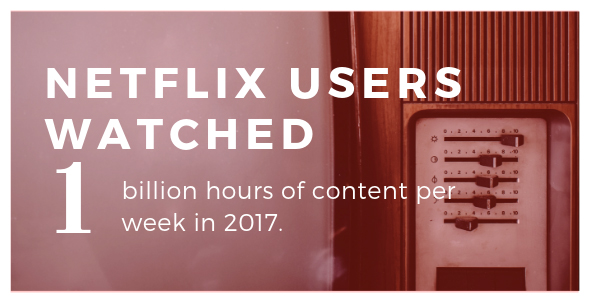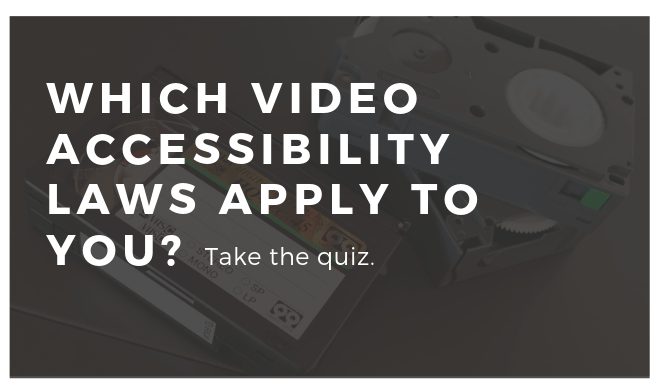62% of On-Demand Providers Don’t Offer Any Access Services
Updated: August 25, 2023
Almost 90% of the U.S. population is reached by television.
Television continues to be one of the most popular mediums to consume video content, but now, thanks to smart devices and streaming services, the culture of television has shifted, and more and more people are watching video-on-demand.
While video is certainly engaging, it’s not readily accessible. Video creators must take extra steps to make video accessible by adding captions and audio description.
For a long time now, video creation and video accessibility have not been growing in sync. In fact, much of the video being published lacks the necessary accommodations for blind, low vision, deaf, and hard of hearing viewers.
How much video is actually accessible?
62% of on-demand providers in the UK don’t offer any access services with their programs. This means that more than half of the on-demand video created had neither captions, nor audio description, nor signing!
When we look deeper into the data, it’s revealed that just 11% of providers offer audio description and only 8% offer signing. And the numbers for captioning aren’t any better. While 36% of providers offer closed captioning, in reality only 7% of content offered by all on-demand providers is actually captioned.
What’s even more problematic is the large discrepancies between what is captioned, described, or signed across different platforms. Even if you have access to captions on your smart TV, it doesn’t mean you’ll be able to watch with captions on your mobile.
All-in-all this creates an unequal viewing experience.
Why isn’t video more accessible?
According to a Nielson poll, we spend over 11 hours a day connected to media. Almost six of those hours are spent watching video.
Our video consumption has exploded, and it’s only going to keep increasing. Video is addicting, engaging, and creative, but it’s also inaccessible without the proper tools.
Accessible video includes captions, transcripts, audio description, and an accessible media player that supports these features. Most video players only support one – captions – which makes it an even bigger challenge to make video accessible.
Another big barrier for content creators is the cost of captioning and describing content. Many organizations have little to no budget for captioning. Because of this, accessibility services aren’t prioritized.
And then there are the vague and often outdated legal requirements. Since many of the laws were written before the internet, their application to today’s digital climate has varied among lawmakers. Fortunately, patterns in legal precedent are showing more and more lawmakers are applying the laws to today’s cyberspace.
What do the laws say about video accessibility?
With the advent of the internet and it’s video takeover, video accessibility laws are more important than ever before.
In the United States, video accessibility laws for on-demand content mandate that anything that previously appeared on television, should be captioned when published on the internet.
The Americans with Disabilities Act (ADA) also states that places of public accommodation must give full and equal enjoyment of goods, services, facilities, or accommodations to individuals with disabilities.
Due to lawsuits against Netflix, Hulu, and Amazon, the ADA has been extended to online-only business. Now, Netflix, Hulu, and Amazon have increased their captioning and description.
In the UK, broadcasters have quotas to meet for captioning their videos. But since the law was created in 2003, the quota is minuscule compared to the current upsurge in video content creation.
Since video accessibility laws vary by country, it becomes harder to create a more consistent and inclusive online environment. The question then becomes, what can we do to make video more accessible?
What can we do to make video more accessible?
Usually, the people who are advocates for video accessibility, are not the ones who are the decision makers for captioning and description.
This demonstrates that there is a big awareness problem, and as a society, we need to keep igniting the conversation of greater online accessibility.
Captions have tremendous benefits for content creators outside of accessibility. Numerous studies have shown that captions improve brand recall, behavioral intent, and verbal memory. Facebook uncovered that captions increase view time by 12%.
In another study by Ofcom, they reported that 80% of people who use captions aren’t deaf or hard of hearing!
Captions give viewers flexibility, ultimately improving the user experience.
As viewers, we can also make an impact to change the industry. By letting content creators and video platforms know that we want a more accessible web, they will begin to drive that change within.
We can already see the impact viewers have had on Netflix. Earlier this year, viewers took to Twitter to complain about the inaccurate captions on Netflix’s Queer Eyed. Swear words where being censored, and a lot of what the Fab Five were saying was being changed.
Karamo Brown, a Fab Five member, saw the tweets from the viewers and brought the case forth to Netflix.
Reading everyone’s comments breaks my heart. I don’t know how much power I have but know, the next time I’m at Netflix I’m going to bring up this issue internally & wont stop until something changes. Deaf & HOH people should have the same experience as everyone else! #TypoFixed https://t.co/AQ4emvgUBv
— Karamo Brown (@KaramoBrown) June 28, 2018
As a result, Netflix is actively making changes to their captions, not just the Queer Eyed captions, but other shows that have been reported as having inaccurate captions.
As viewers, we have the power to make a difference and change the video industry.
3Play Media provides closed captioning, transcription, subtitling, and audio description services. Click below to get started.
Further Reading

Subscribe to the Blog Digest
Sign up to receive our blog digest and other information on this topic. You can unsubscribe anytime.
By subscribing you agree to our privacy policy.











